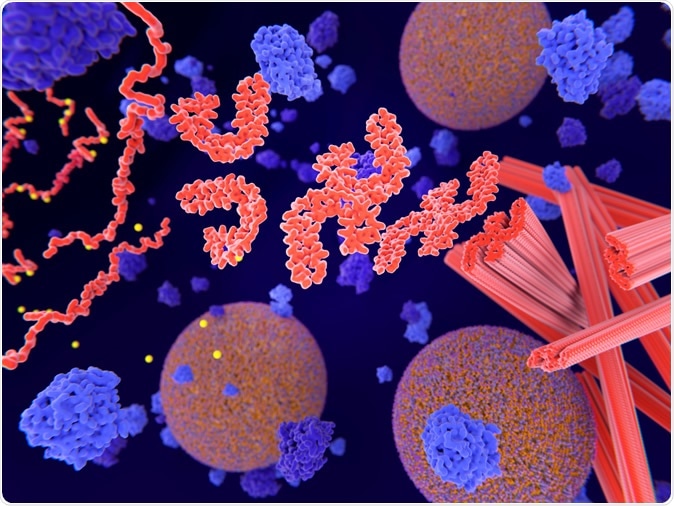Studies have shown that Alzheimer’s disease (AD) incidence increases with age. This association with age also correlates with deposits of abnormal tau protein in the brain found a new study. Susanne Wegmann and colleagues of German Centre for Neurodegenerative Diseases (DZNE) in Berlin in close collaboration with researchers from US Harvard Medical School and Massachusetts General Hospital worked on experimental animals to prove that abnormal tau folding and deposits in specific regions of the brains (Entorhinal cortex of young and old mice) was related to AD. Their study titled “Experimental evidence for the age dependence of tau protein spread in the brain,” was published in the recent issue of the journal Science Advances. The experiments were conducted in the laboratory of Bradley Hyman at Harvard Medical School in Boston, USA.

Alzheimer's disease: Tau proteins aggregate to neurofibrillary tangles in a neuron axon. The transport of synaptic vesicles is disrupted. 3d rendering - Illustration Credit: Juan Gaertner / Shutterstock
Alzheimer’s disease (AD) is a progressive dementia that starts with memory decline and then impairs cognitive abilities. The risk of developing AD is age dependent, rarely being detected before the age of 50. There is a gradual increase in incidence with age and more than half the population is affected by 90 years of age. There are two types of proteins that get deposited in brain and cause the disease. These are “amyloid beta plaque” and “tau neurofibrillary tangle”. The deposition and progressive spread of the “tau neurofibrillary tangles” are responsible for the progression of disease as they first get deposited in the memory centres and then spread along nerves to other areas of the brain. The correlation between increasing age and the incidence of AD has been attributed to these proteins that spread more easily in the aging brain.
For this new study the team worked with young and old mice. In the Entorhinal cortex region of these animals they used gene vectors carrying viral molecules to cause deposits of tau protein. These tau proteins were “immune-labelled” which allowed the team of researchers to examine them closely during the experiment. The factors affecting the spread of tau proteins like age of the animal, the specific brain region and misfolding of tau were assessed. The team explains that tau protein exists as two variants - a healthy form dissolved in neurons and a diseased form that exists as fibrils and aggregates. Wegmann said in a statement, “It has long been thought that it is primarily the pathological form of tau that passes from one cell to the next. However, our results show that the healthy version of the protein also propagates in the brain and that this process increases in old age. Cells could also be harmed by receiving and accumulating large amounts of healthy tau.”
The vectors were programmed to make tau protein were injected into the brains of mice. The researchers then studied its propagation using processes like immunostaining and flow cytometry. Till date scientists have been able to look at only tau deposits and not its spread across the brain in folded and misfolded states. This study was a step forward in studying the misfolded tau proteins in the brains of the experimental animals.
To analyze the dependence of tau propagation and misfolding on age, young mice aged 3 months and older mice (22-24 months) were injected with tau in the entorhinal cortex (EC).
Results revealed that there was detectable spread into hippocampus and adjoining cortex. Over a period of 12 weeks there was a greater spread of the tau protein in the mice. This corroborated with the initial hypothesis that as the brain ages, it becomes a breeding ground for faster spread of tau protein. There was also considerable tau misfolding that led to its faster spread write the researchers.
In aged EC the team noted three fold higher amount of tau protein. The reason behind this was not clearly understood. In older mice, the researchers speculated, there would be a faster spread of tau and increased misfolding and accumulation of the proteins. The team also speculates that there may be DNA damage in the cells and this could be the reason behind tau accumulation and misfolding.
Further the team noted that tau protein accumulated more in regions such as the EC but were not similarly clumped in the striatum region of the brain. The researchers speculate that this could be due to the differences between the cells and neurons that influence transmission as well as misfolding of the proteins.
A notable finding was that the tau proteins that were misfolded did not develop the typical neurofibrillary tangles as early as non-misfolded tau proteins. This meant that spread of the tau protein and its clumping and aggregation were two different phenomenon and thus had a separate set of factors influencing them. Authors explain that the tau molecules can spread without being misfolded and tau misfolding is not essential for tau spread. They write that this could provide therapy options to prevent tau protein propagation in brains developing AD concluding, “It appears that under complex in vivo conditions, neurons seem to be capable of maintaining tau in a misfolded, nonaggregated state, which reinforces the possibility for a potential therapeutic window, in which one could stop the spread of tau pathology by targeting the propagation of tau regardless of its conformational state.”
Journal reference:
Susanne Wegmann, Rachel E. Bennett, Louis Delorme, Ashley B. Robbins, Miwei Hu, Danny McKenzie, Molly J. Kirk2 Julia Schiantarelli, Nahel Tunio, Ana C. Amaral, Zhanyun Fan, Samantha Nicholls, Eloise Hudry and Bradley T. Hyman, Experimental evidence for the age dependence of tau protein spread in the brain, Science Advances 26 Jun 2019, DOI: 10.1126/sciadv.aaw6404, https://advances.sciencemag.org/content/5/6/eaaw6404